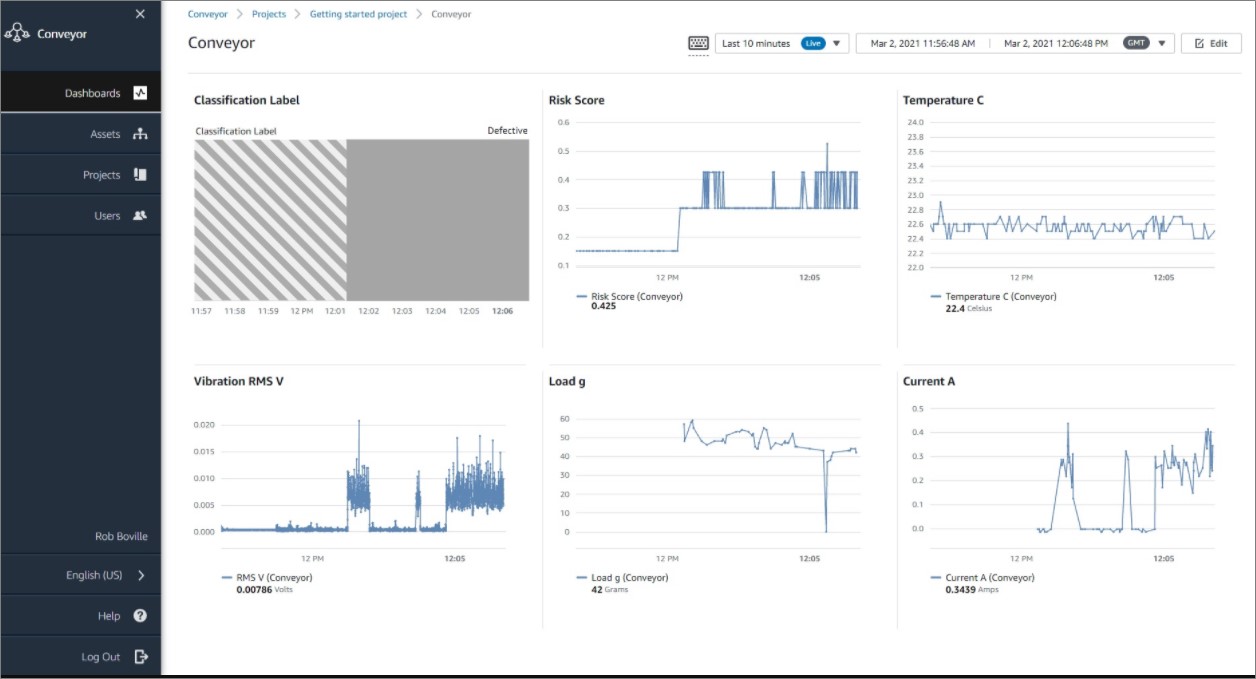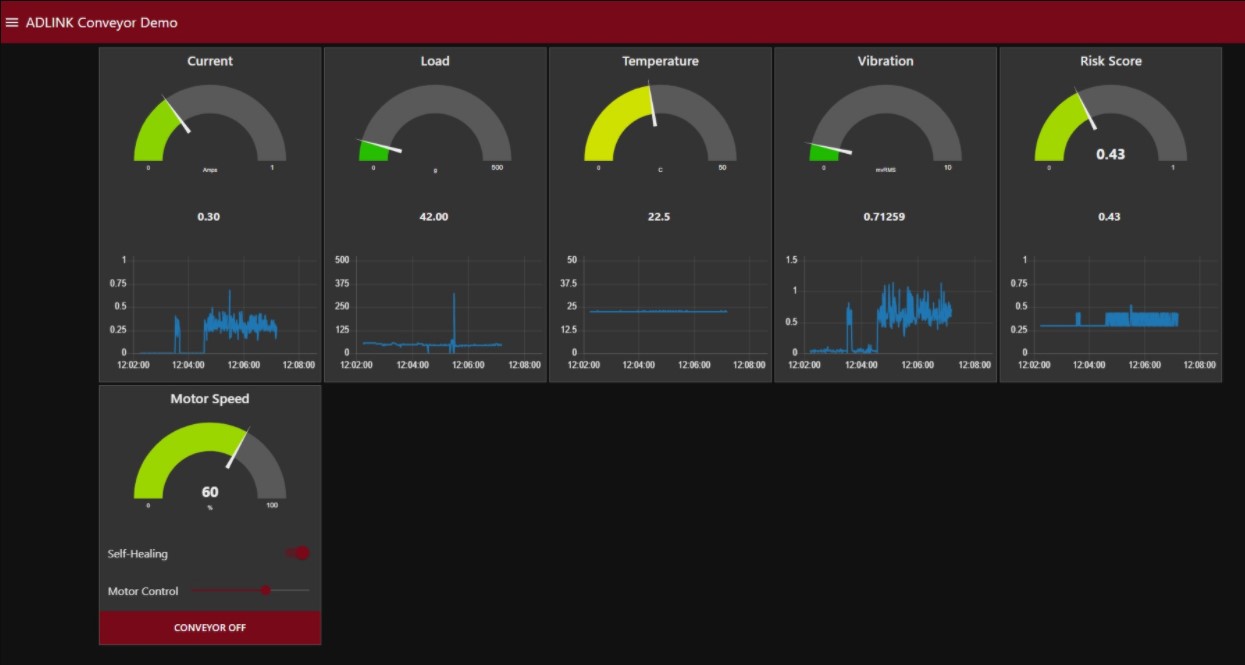AWS Partner Network (APN) Blog
Drive Action with Automated Quality Inspections Using AWS IoT Greengrass 2.0, AWS IoT SiteWise, and ADLINK Edge
By Krishna Doddapaneni, Partner Solutions Architect – AWS
By Jared Knapp, Partner Solutions Architect – AWS
By Rob Boville, Head of Engineering and Architecture – ADLINK
 |
Issues on a conveyor belt-driven production line can easily be missed or overlooked, leading in some cases to damaged products and costly repairs.
Those issues can be classed into two categories:
- Problems with the product that has been manufactured.
- Problems with the conveyor which requires maintenance.
The resulting downtime can be costly and lead to missed production targets. Manual quality inspections can help prevent some of these problems but is time consuming, inaccurate, and causes bottlenecks in performance.
The solution to this challenge can be found in the unique combination of ADLINK and Amazon Web Services (AWS) technologies. At the edge, ADLINK Edge hardware and software monitors production line data as they are happening in real-time. This can include vibration, temperature, and load to identify system health issues.
ADLINK’s machine vision platform can detect defects in products as they move along the conveyor line. AWS IoT Greengrass 2.0 provides the secure link between edge solutions and the cloud. Telemetry information generated at the edge is collected and relayed to cloud-based services, and updated configuration information is returned to the edge.
AWS IoT SiteWise collects and organizes data across factories and geographical locations to show the status of production lines, while ADLINK Edge helps to quickly identify issues in a way that’s easy to understand and analyze.
The result is a secure system that enables rich and informative decision-making to enable artificial intelligence (AI)-guided solutions, such as quality inspections of operations and production, as well as alerts when actions are required.
Detecting Issues and Defects Early to Avoid Production Delays
Production lines produce a huge number of products every day, and common issues that can occur include:
- Quality control: Providing an expert eye to monitor a product for defect on a fast-paced production line is not something a human can do.
- Maintenance: Parts experience regular wear and tear, which is not always detected early and can cause a decrease in throughput over time. Worse, it can cause a part to break and stop the entire production line.
- Lack of real-time information: Without accurate, ongoing, real-time information in a central location, it’s difficult to monitor the production lines and see potential issues to proactively act.
- Safety issues: When manning production lines, safety is key and if production lines increase their speed of operation there is more risk involved. Better connectivity between all parts of the production line is required to reduce the risk of damage, which is often detected too late and causes a huge amount of waste.
- Bottlenecks: Human visual inspections can be timely but inaccurate, and cause bottlenecks in the production line.
AI-Based Defect Detection Drives Actions from a Central Location
Automating defect detection requires an integrated, end-to-end system of hardware and software capable of generating insights in real-time. The solution is ADLINK’s IoT and machine vision platform, also known as ADLINK Edge.
Sensors capture physical data about the conveyor (temperature, load, speed, and vibration, for example) and use an ADLINK engine to produce a risk score for each conveyor to then act on it. ADLINK Edge supports the seamless integration of software and hardware to capture, stream, process, understand, and act on all captured data whether it’s sensor data or vision.
With ADLINK Edge, you can automatically control the speed of a conveyor belt that has been identified as causing defects or that’s showing a high-risk score. If necessary, you can stop the conveyor.
AWS IoT Greengrass 2.0 helps you to collect, process, and export data streams from Internet of Things (IoT) devices and manage the lifecycle of that data on the device to minimize development time. AWS IoT Greengrass 2.0 also provides a standard mechanism to process data streams, manage local data retention policies, and transmit device data to AWS services such as Amazon Simple Storage Service (Amazon S3), Amazon Kinesis, AWS IoT Core, and AWS IoT Analytics.
In this use case, AWS IoT Greengrass 2.0 feeds the data into AWS IoT SiteWise to monitor the status of your conveyors globally. This connection allows you to collect data consistently across devices and then organize and display it in dashboards that are easy to understand and analyze.
You can also configure alarms that alert your team when equipment or processes perform sub-optimally, and even control the speed of your conveyor systems. This helps you to quickly identify defects and react to them appropriately.
Figure 1 – Reference architecture for vision-driven conveyer belt system.
The reference architecture above shows the complete end-to-end implementation of the solution. A step-by-step view of the reference architecture is presented below.
How it Works
- Step 1: An ADLINK NEON Smart Camera is fixed above the conveyor belt to capture images of the products moving along, and performs real-time inferencing on them to detect defects in your product.
- Step 2: ADLINK’s vast array of apps allows you to monitor temperature, load, speed, and vibration captured by sensors attached to the conveyor.
- Step 3: Node-RED consumes all of the sensor data and AI inferences results to generate a health score. The data collected from ADLINK’s IoT and vision system, ADLINK Edge, and all other edge applications is published to the Data River.
- Step 4: AWS IoT Greengrass 2.0 subscribes to the data on the Data River and sends it to AWS IoT Core.
- Step 5: VMLINK can be leveraged to monitor video and inference results, if necessary.
- Step 6: Data received in AWS IoT Core is routed to AWS IoT SiteWise, which displays the status of every conveyor in every site. You can also compute industrial performance metrics and create applications to analyze. This means you can easily spot when a machine has been stopped or slowed and respond to the issue without producing any further defective products.
- Step 7: ADLINK OT Connect instructs the Siemens S7 PLC to control the conveyor’s motor based on the health score generated.
The images below show the status of the conveyer on one site. Temperature, vibration, load, and current are captured by the sensors, while risk score is computed and the data is presented on AWS IoT SiteWise display.
It’s evident that as the temperature spiked up, the risk score also spiked up.
Figure 2 – AWS IoT SiteWise dashboard showing captured sensor values and computed risk score.
Figure 3 – ADLINK Node-RED dashboard displaying captured sensor data.
Figure 4 – AWS IoT SiteWise dashboard showing spike in the risk score due to temperature spike.
Using AI at the edge, the solution enables ultra-fast intelligence and automation by deploying data closest to its source, decreasing latency and enabling real-time decision making and corrective action.
Demo Video (10:40)
Watch our video demonstration to see how to detect defects and drive action in real-time on a production line, using a machine vision AI system integrating AWS IoT SiteWise and AWS IoT Greengrass 2.0 with ADLINK Edge.
Summary
AWS IoT Greengrass 2.0, AWS IoT SiteWise, and ADLINK Edge make production lines intelligent by connecting and integrating between cameras, conveyors, automation systems, factory management systems, and cloud.
The combination of data acquisition and automated action at the edge—along with data analysis, management, and training in the cloud—offers a secure system that enables rich and informative decision-making based on AI-guided solutions, such as quality inspection of operations and production.
The end result for manufacturers for continuously improving operations and process efficiencies..

.
ADLINK – AWS Partner Spotlight
ADLINK is an AWS Partner and global leader in edge computing whose mission is to affect positive change in society and industry by connecting people, places and things with AI.
Contact ADLINK | Partner Overview
*Already worked with ADLINK? Rate the Partner
*To review an AWS Partner, you must be a customer that has worked with them directly on a project.



